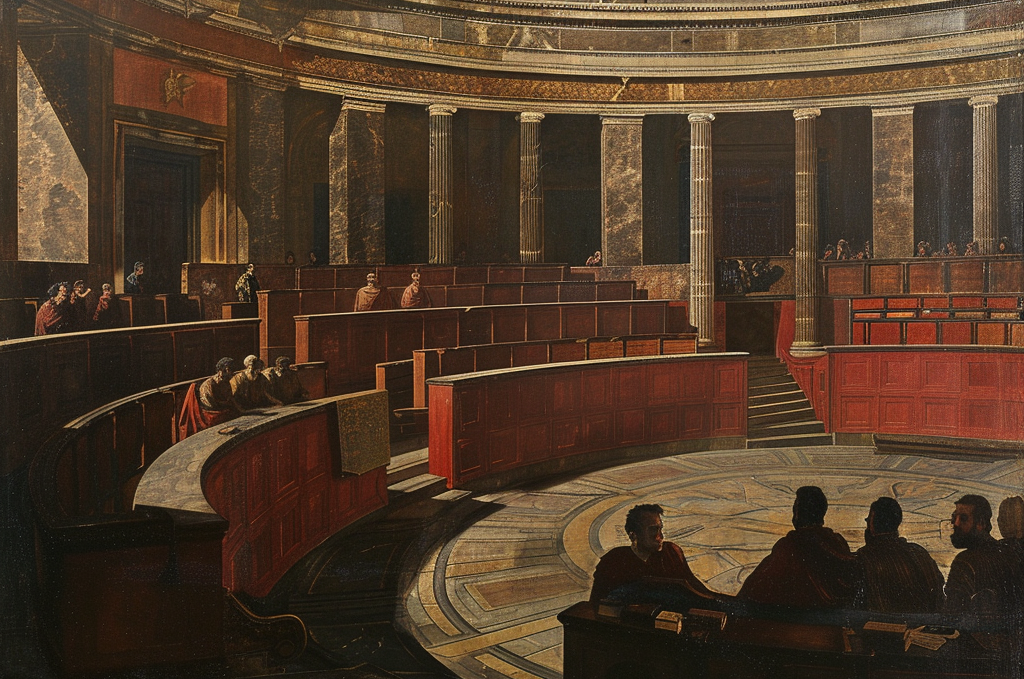With the benefit of 2,000 years of hindsight, we can confidently say that the Roman Republic died around the time Julius Caesar crossed the Rubicon. Whatever was left vanished when Augustus ascended to his imperium. However, it did not necessarily seem that way to the Roman people. Patricians still elected senators, who elected consuls, and they continued to deliberate and debate the issues of the day. It wasn’t until Diocletian’s reforms in AD 300 that the de jure power of the Senate was officially curtailed, but the body continued to meet until well after the fall of the Western Roman Empire in AD 476.
I often receive pushback when I say that I believe the Constitution as written in 1787 is essentially a dead letter in 2024. I’ve been accused of wanting to eliminate the Constitution, when in reality I have simply recognized that, for most intents and purposes, the document no longer constrains our government as it was meant to. Yet because the document still exists and is still given lip service as the supreme law of the land, many assume that it is still fully in force.
It’s easy to cry about unconstitutional government overreach, but it’s another thing to have a plan to do something about it. I think many conservatives believe that if we sit back and wait, eventually people will “wake up” and realize that our country is on the wrong track. How is that working out?
When Central District Health imposed a mask mandate on citizens and businesses, many of us agreed it was unconstitutional. Yet the way the mandate was ended was by electing two Republicans to the Ada County Board of Commissioners — Rod Beck and Ryan Davidson — who then appointed Raúl Labrador to the Central District Health board. This gave the anti-mandate side enough votes to rescind the order and allow people to breathe freely once more. This victory happened because of actions, not words. Having the wrong people in a position of authority created the problem, but putting the right people in that position made all the difference.
The original conception of authority in our country was that it was local and accountable. States had certain powers that the federal government did not have—for example, the First Amendment prohibited the federal government from establishing a national church, but nothing stopped states from having their own established denominations. The Tenth Amendment explicitly stated that any powers not specifically granted to the federal government were reserved to the states. The federal government, for its part, had a limited scope: national defense, foreign policy, international trade, and anything that crossed state lines, like the postal service and eventually railroads.
The House of Representatives was elected by voters while the Senate represented state legislatures in Congress. Meanwhile, electors voted for president, whose power balanced that of the legislative branch. The idea that the Supreme Court had the final say on whether or not laws were constitutional was not actually in the Constitution, but assumed by Chief Justice John Marshall in Marbury v. Madison.
Consider how that same government, under the same Constitution, operates today. The Fourteenth Amendment radically altered the scope of the federal government’s authority, establishing that federal law essentially preempts state and local laws. While this has been beneficial in some ways—protecting our Second Amendment right to carry firearms, for example—it also completely subordinated the states to a growing federal government.
The Seventeenth Amendment continued this subordination by making senators directly elected by the people. No longer would state legislatures have a voice in the federal Congress, which meant the power of the states to stand up to federal overreach would inevitably be reduced.
Today, both the states and Congress have delegated the powers granted them by the Constitution to a rapidly expanding federal bureaucracy, an administrative state that rules like an egregoric dictator with a million tiny iron fists.
The rise of the administrative state since the 1930s has radically changed the relationship of government to the citizens, but because it happened so long ago, even conservatives have a hard time conceiving of anything different. The executive branch of the federal government amassed tremendous power in the two decades following the election of President Franklin Roosevelt, and once it had that power, it only continued growing. The Great Society programs enacted by President Lyndon Johnson increased the authority of the federal bureaucracy to micromanage the lives of every single citizen.
It’s hard to comprehend exactly how much authority has been amassed by the executive branch over the last century because it has happened so gradually. Republicans have traditionally fought this expansion, but once each battle is lost, they move on to the next one, ceding ground to the ever-expanding bureaucracy. In the early 1990s, Republicans warned that “Hillarycare” was dangerous because it would nationalize one-sixth of the nation’s economy. Democrats passed Obamacare in 2010, the Supreme Court saved it, Republicans failed to repeal it, and now it remains as a monument to inefficient government processes. When was the last time you heard a Republican talk about repealing it? It’s only been 14 years, yet this bureaucratic parasite is so embedded into our system that nobody knows how to get it out.
There has been some positive news, however. The Supreme Court has been slowly dismantling the powers of the administrative state over the past few years. In 2022, the Court ruled in West Virginia v. EPA that the Environmental Protection Agency had overstepped its authority regarding certain power plant regulations, and in last year’s Sackett v. EPA it ruled against the agency in a conflict with a small landowner. Today, the Court ruled against the Securities and Exchange Commission in SEC v. Jarkesy, stating that agencies cannot simply declare a citizen guilty of breaking civil law and fine them with no recourse.
One of the results of the growth of the administrative state has been the ability of government bureaucrats to not only create rules but to enforce them as well. They can take a law, such as the Securities Act of 1933 for the SEC or the Clean Water Act of 1973 for the EPA, and expand its scope without congressional oversight. Not only that, but these agencies then claim the right to declare citizens in violation of those expanded rules and levy fines or even jail time without due process.
The Supreme Court ruled 6-3 that the SEC does not, in fact, have that right, and that citizens facing such punishments have the inalienable right to a trial by jury. This is great news, and I am pleased that the Court continues to fight back against the administrative state.
Consider, however, that the three liberal justices—Sonia Sotomayor, Elena Kagan, and Ketanji Brown-Jackson—voted in the minority here. Sotomayor, in particular, argued that requiring jury trials would make it more difficult for agencies such as the SEC to operate, to which most conservatives would respond, “And the problem is?”
The Constitution itself did not rise up and strike down this expansion of government. As a piece of paper, it cannot grow arms and legs and defend itself. It relies on human beings to exercise their own moral agency. Justices Sam Alito, Clarence Thomas, Brett Kavanaugh, Neil Gorsuch, and Amy Coney Barrett are responsible for this curtailment of the administrative state because they took their beliefs about the nature of the Constitution and the rights it was created to protect and put them into practice.
Consider again that three of those six were appointed by President Donald Trump. Had Hillary Clinton won the 2016 election, it is almost certain that SEC v. Jarkesy would have gone the other way. Sackett v. EPA and Dobbs v. Jackson Women’s Health would likely have been decided differently as well. For those who believe in constitutional principles, would these outcomes have changed your mind about what was right? Of course not. Yet, like Roe v. Wade, they would have been the law of the land for the next half century or more.
We look back on the history of Rome and see clearly that the ascendancy of Augustus Caesar ended the real authority of the Senate, and with it, the Republic. Will future historians look back on the history of America and say that the real power of Congress, and with it our own Republic, ended in 1933, 1965, or 2010? Or can we claw back the republican form of government as envisioned by our founders?
When I say the Constitution is just a piece of paper, I mean that it has no will of its own. It relies on people, flesh and blood, to fight for the principles written on that paper. John Adams said it was made for a moral and religious people, and we are clearly not the same people we were in 1787. Yet perhaps there are still a few left, a remnant that can work toward a restoration or reconquest of our nation. In 2016, Donald Trump won the presidency because of a few thousand votes in a handful of swing states, and once there, he appointed three people to the Supreme Court who still believe in the principles our Constitution was made to defend. It really is hanging by a thread, isn’t it?
So long as the instruments of our government continue going through their constitutional motions, it’s easy to forget how radically our nation has changed in the past 250 years. Do not let that blind you to the necessity of supporting brave men and women who will do what needs to be done to save our country and restore the principles our founders fought and died for.
Paid subscribers, click over to Substack for a bonus note. Not subscribed? You can do that today!
About Brian Almon
Brian Almon is the Editor of the Gem State Chronicle. He also serves as Chairman of the District 14 Republican Party and is a trustee of the Eagle Public Library Board. He lives with his wife and five children in Eagle.













